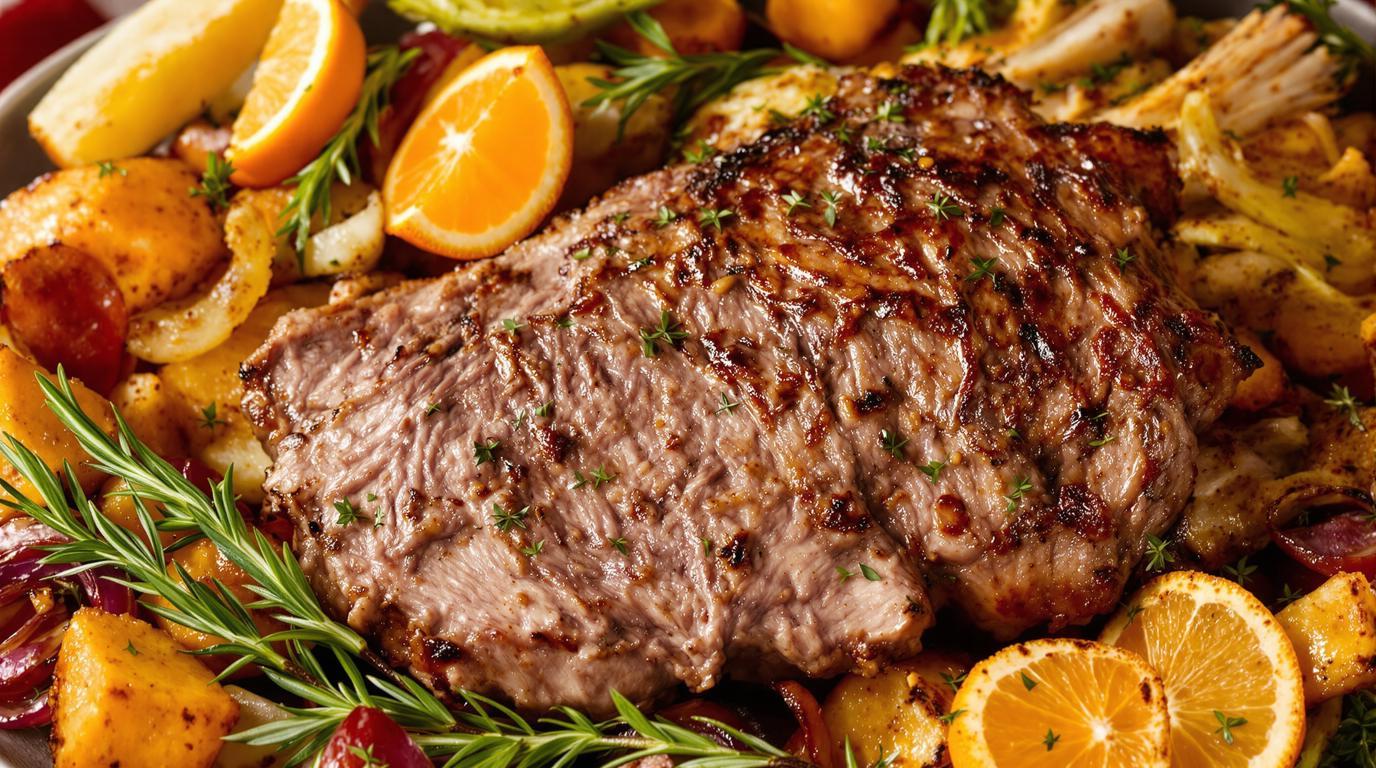I learned to roast lamb from my grandmother who lived in a small village outside Thessaloniki. Her kitchen always smelled of garlic, herbs, and the sweet citrus she’d hang to dry by the window. While many associate Greek lamb with Easter celebrations, in her coastal village, they’d prepare slow-roasted lamb shoulder year-round, often incorporating the vibrant fennel that grew wild on nearby hillsides. The addition of orange might seem unorthodox to some, but this bright citrus note actually has deep roots in Greek coastal cooking, where sea breezes carry the scent of citrus groves directly into home kitchens. 🌿🍊
The Magic of Slow-Roasted Greek Lamb 📖
What makes Greek lamb shoulder special isn’t just the ingredients—it’s the patience. This isn’t fast food; it’s slow food in the truest sense. We’re talking about a transformation that happens over hours, as tough connective tissues surrender into silky, melt-in-your-mouth textures. The combination of fennel’s subtle anise notes with bright orange creates a foundation that lifts the rich lamb without overwhelming it.
In my early days at the Culinary Institute, I was taught lamb should never be “aggressive”—it should taste of the herbs the animal grazed upon. This preparation honors that philosophy, letting the meat’s natural flavor shine while the aromatics work their supporting magic. 🌱
Essential Ingredients 🧾
For this recipe, you’ll need:
- 3½–4 lbs (1.6–1.8 kg) bone-in lamb shoulder
- 8 garlic cloves (4 slivered, 4 minced)
- 4 sprigs fresh rosemary, leaves stripped and chopped
- 2 sprigs fresh thyme
- 1 tablespoon orange zest + ¼ cup fresh juice
- ¼ cup fresh lemon juice
- ½ cup extra virgin olive oil
- 2 teaspoons sea salt
- 1 teaspoon freshly ground black pepper
- 1 teaspoon dried Greek oregano
- 2 large fennel bulbs, trimmed and cut into wedges
- 2 lbs (900g) Yukon Gold potatoes, peeled and wedged
- 1 large red onion, quartered
- ½ cup chicken stock or water
Chef’s Note: The quality of your olive oil matters tremendously in this dish. Use the good stuff—the one you save for special occasions. Greek olive oil with its peppery finish works beautifully, but any high-quality extra virgin olive oil will enhance the Mediterranean flavors.
Creating Greek Lamb Magic, Step by Step 📝
1. Prepare the lamb (2 hours before cooking): Using a sharp paring knife, make 6-8 deep incisions all over the lamb shoulder. Insert slivers of garlic and rosemary leaves into each cut. This technique infuses flavor directly into the meat—something I learned watching my grandmother work her magic.
2. Make the marinade: In a bowl, combine minced garlic, orange zest, orange juice, lemon juice, olive oil, thyme leaves, oregano, salt, and pepper. Whisk until emulsified. Rub this aggressively all over the lamb, massaging it into the meat. Refrigerate for at least 2 hours, though overnight is even better. Much like Nonna’s tomato sauce, patience here yields profound depth.
3. Preheat your oven to 450°F (230°C) with a roasting pan inside to get it hot.
4. Sear the lamb: Carefully remove the hot pan, add 2 tablespoons olive oil, and place the lamb fat-side up. Roast uncovered for 15 minutes to develop a beautiful brown crust.
5. Prepare the vegetables: While the lamb sears, toss fennel wedges, potato chunks, and onion quarters with 2 tablespoons olive oil, salt, pepper, and a pinch of oregano.
6. The slow-roast transformation: Reduce oven to 300°F (150°C). Arrange the vegetables around the lamb, pour in the stock, and cover tightly with foil. Roast for 2½ hours, then uncover, baste with pan juices, and continue roasting uncovered for another 45-60 minutes until the meat easily pulls away with a fork. The total cooking time is about 3½ hours—reminiscent of how Grandma’s chicken and noodles develop their flavor through gentle cooking.
7. Rest and finish: Remove the lamb and let it rest for 20 minutes. Meanwhile, increase the oven temperature to 425°F (220°C) and return the vegetables to crisp up for 15 minutes.
Chef’s Secret Techniques 🤫
The key to perfect lamb shoulder lies in temperature control. The initial high-heat sear creates the Maillard reaction—that complex flavor development that can’t happen at lower temperatures. But the magic truly happens during the long, slow roast, where collagen converts to gelatin, creating that melt-in-your-mouth texture.
Basting is essential, but restraint is virtue—once every hour is sufficient. Over-basting cools the meat and dilutes the developing flavors. Like perfecting silky soft-boiled eggs, timing matters.
If you can’t find fennel, celery makes a respectable substitute, though you’ll lose the subtle anise notes. No fresh oranges? Use all lemon juice plus a teaspoon of honey to mimic the sweet-tart balance. The technique for preparing this lamb reminds me of how Grandmother’s mayonnaise trick relies on proper emulsion—everything must come together in harmony.
Serving & Final Touches 🍽️
Serve this glorious lamb with its vegetables on a large platter, garnished with fresh herbs and orange slices. A side of Greek yogurt mixed with grated cucumber, garlic, and fresh dill makes a cooling accompaniment, balancing the rich meat. A robust Greek red wine like Agiorgitiko completes the experience.
Remember, the measure of perfect lamb isn’t just in taste, but in the way it brings people together around a table, creating memories that linger long after the plates are cleared—just like Scottish Grandma’s porridge creates morning moments to cherish. Cook with love, serve with pride, and watch as your table falls silent with that first perfect bite. Kali Orexi! (Good appetite!) 🍷🇬🇷
